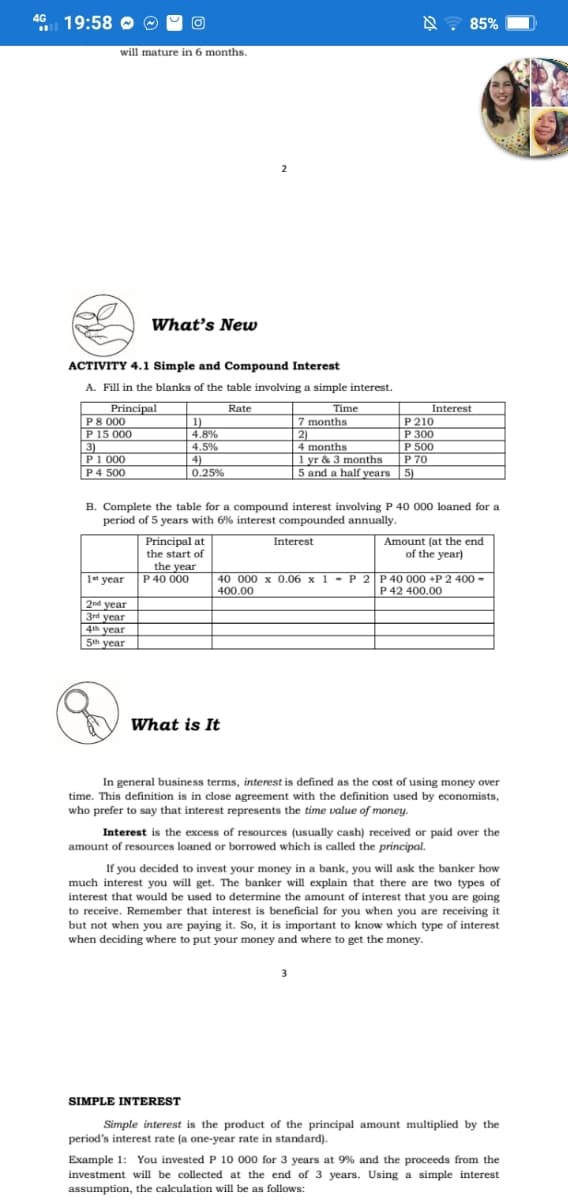What's New ACTIVITY 4.1 Simple and Compound Interest A. Fill in the blanks of the table involving a simple interest. Principal P8 000 P15 000 3) P1 000 P4 500 Interest Time 7 months 2) 4 months Rate 1) 4.8% P210 P 300 P 500 P 70 5 and a half years 5) 4.5% 1 yr & 3 months 4) 0.25% B. Complete the table for a compound interest involving P 40 000 loaned for a period of 5 years with 6% interest compounded annually. Principal at the start of the year P 40 000 Interest Amount (at the end of the year) 1 year 40 000 x 0.06 x 1 - P 2 P 40 000 +P 2 400 - 400.00 P 42 400.00 2nd year 3d year 4h year 5 year
What's New ACTIVITY 4.1 Simple and Compound Interest A. Fill in the blanks of the table involving a simple interest. Principal P8 000 P15 000 3) P1 000 P4 500 Interest Time 7 months 2) 4 months Rate 1) 4.8% P210 P 300 P 500 P 70 5 and a half years 5) 4.5% 1 yr & 3 months 4) 0.25% B. Complete the table for a compound interest involving P 40 000 loaned for a period of 5 years with 6% interest compounded annually. Principal at the start of the year P 40 000 Interest Amount (at the end of the year) 1 year 40 000 x 0.06 x 1 - P 2 P 40 000 +P 2 400 - 400.00 P 42 400.00 2nd year 3d year 4h year 5 year
Chapter1: Financial Statements And Business Decisions
Section: Chapter Questions
Problem 1Q
Related questions
Question

Transcribed Image Text:4G
19:58 O O
A. 85%
will mature in 6 months.
2
What's New
ACTIVITY 4.1 Simple and Compound Interest
A. Fill in the blanks of the table involving a simple interest.
Principal
P8 000
P 15 000
3)
P1 000
Rate
Time
Interest
7 months
2)
4 months
1 yr & 3 months
5 and a half years 5)
1)
4.8%
P210
P 300
P 500
P 70
4.5%
4)
P4 500
0.25%
B. Complete the table for a compound interest involving P 40 000 loaned for a
period of 5 years with 6% interest compounded annually.
Principal at
the start of
the year
P 40 000
Interest
Amount (at the end
of the year)
1t year
40 000 x 0.06 x 1- P 2 P 40 000 +P 2 400 -
400.00
P 42 400.00
2nd year
3rd year
4th year
5h year
What is It
In general business terms, interest is defined as the cost of using money over
time. This definition is in close agreement with the definition used by economists,
who prefer to say that interest represents the time value of money.
Interest is the excess of resources (usually cash) received or paid over the
amount of resources loaned or borrowed which is called the principal.
If you decided to invest your money in a bank, you will ask the banker how
much interest you will get. The banker will explain that there are two types of
interest that would be used to determine the amount of interest that you are going
to receive. Remember that interest is beneficial for you when you are receiving it
but not when you are paying it. So, it is important to know which type of interest
when deciding where to put your money and where to get the money.
3
SIMPLE INTEREST
Simple interest is the product of the principal amount multiplied by the
period's interest rate (a one-year rate in standard).
Example 1: You invested P 10 000 for 3 years at 9% and the proceeds from the
investment will be collected at the end of 3 years. Using a simple interest
assumption, the calculation will be as follows:
Expert Solution
This question has been solved!
Explore an expertly crafted, step-by-step solution for a thorough understanding of key concepts.
This is a popular solution!
Trending now
This is a popular solution!
Step by step
Solved in 3 steps

Knowledge Booster
Learn more about
Need a deep-dive on the concept behind this application? Look no further. Learn more about this topic, accounting and related others by exploring similar questions and additional content below.Recommended textbooks for you


Accounting
Accounting
ISBN:
9781337272094
Author:
WARREN, Carl S., Reeve, James M., Duchac, Jonathan E.
Publisher:
Cengage Learning,

Accounting Information Systems
Accounting
ISBN:
9781337619202
Author:
Hall, James A.
Publisher:
Cengage Learning,


Accounting
Accounting
ISBN:
9781337272094
Author:
WARREN, Carl S., Reeve, James M., Duchac, Jonathan E.
Publisher:
Cengage Learning,

Accounting Information Systems
Accounting
ISBN:
9781337619202
Author:
Hall, James A.
Publisher:
Cengage Learning,

Horngren's Cost Accounting: A Managerial Emphasis…
Accounting
ISBN:
9780134475585
Author:
Srikant M. Datar, Madhav V. Rajan
Publisher:
PEARSON

Intermediate Accounting
Accounting
ISBN:
9781259722660
Author:
J. David Spiceland, Mark W. Nelson, Wayne M Thomas
Publisher:
McGraw-Hill Education

Financial and Managerial Accounting
Accounting
ISBN:
9781259726705
Author:
John J Wild, Ken W. Shaw, Barbara Chiappetta Fundamental Accounting Principles
Publisher:
McGraw-Hill Education